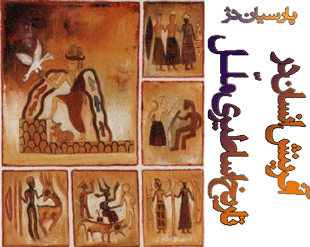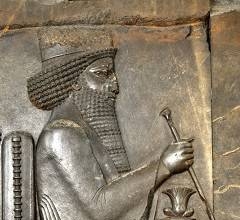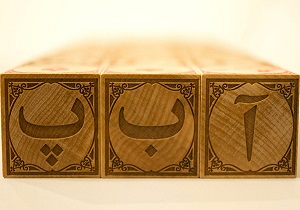The creation of man in the mythological history of various nations(second part)
(second part)
Click here to see the first part
8 – The creation of man in Egyptian mythological history
Atom
Atom, the "god of Heliopolis" and the "god of the heavens," creates the creator god of the material world, who at the beginning of time re-creates [The symbol of "non-existence" before creation, the boundless ocean of water living in darkness] Exits to build the elements of the universe. As the god of the sun, he evolves himself and becomes an existence. In the name of the atom lies a kind of concept of totality, so he is unique as the god of the sun, the transcendent existence and essence of all the forces and elements of nature.. Therefore, the life force contains all the other gods that will come into being later.
In Egyptian mythology, during different periods of this civilization, different gods and goddesses have been placed on the throne of the godliness of the world, but the only goddess that has always been respected and worshiped in this civilization is a goddess called Maat, who is a symbol and sign. She (Which was transferred to his wife Isis during the worship of Osiris) It is a hieroglyphic symbol. This hieroglyphic symbol is called "Ankh" by the Egyptians. The shape of this symbol is undoubtedly familiar to you because today it is known as the symbol of the female sex.
Source : The book of Egyptian myths from the collection of books "Myths of Nations", published by Markaz
9 _ The creation of man in the mythical history of Babylon
The Babylonians believed in a deity named Apsu and another deity called Tiamat. They form a creature. (Giant) The turbulent sea, this sea over time becomes part of the existence of the god Tiamat to the giant who takes control of the world and by the gods Marduk(He was the first to determine the position of the gods and created man from the blood of the king. The tablets of destiny were in Marduk's possession. He casts out evil spirits that destroy the light of the moon god (Sen.) Had been defeated.) Moves for destruction . And by tearing different parts of Tiamat's body by Marduk, creatures are created.
Source:
Alphabetic-thematic culture of ancient Iranian mythology, Maliha Karbasian, Akhtaran Publishing
10 . The creation of man in Scandinavian mythological history
In the myth of creation In Scandinavian mythology, at the time of the creation of man, the first three deities were Odin.(Odin is the god of gods in Nordic mythology. Odin is both the god of war and death and the god of poetry and wisdom.. He was hungry and thirsty for nine days and hung from Igdrazil while being wounded by his own spear. (That is why the name Igdrazil is given to the world tree. Ig is one of the titles of Odin and means scary) And after this time he fell, learning nine magic hymns and eighteen runes. In this way he was able to persuade the dead to speak and to consult with the wisest of them. ), Willie(Vili is said in Norse mythology to be Odin's brother and Wiley.)وه(In the Norse mythology, Ve is the son of Bohr and Bastla, and thus the brother of Odin and Willie, who together killed the Emir and created the world.. During the creation of the first man and woman, it is said that He gave humans the power of speech as well as the five senses.. ), The first man, Aske, is made from a stump of a sparrow tree, and the first woman, Ambla, is made from a stump of an alder tree.. The myth that the sparrow tongue tree unquestionably introduces a masculine element.
On the other hand, in Scandinavian mythology, the element is the support of the world (As in other mythical systems of the earth) There is a huge sparrow tongue called Igdrazil.
یگدراسیل: The tree of the world is in Scandinavian mythology. The Sparrow Tree, on which the nine worlds of the Viking world are located, has a special place in their mythology..
In Scandinavian mythology, Igdrasil, which means "its only terrifying horse" and is also called the universal tree, is the giant sparrow tree that covers all parts of the world. (The world of Scandinavian mythology has nine parts) Connects and protects. Igdrasil has numerous and long roots that we only know the location of its three roots:
There is a root in Asgard, and beneath it lies the well of destiny, the Ordarbrunner, which is cared for by the Norians..
The second root reaches Utonheim, and the micro well, the Mizbrunner, lies beneath this root..
But the third known root of Igdrasil is in Nifelheim, above a well known as Horgelmeier, from which many rivers are said to originate..
Numerous dangers always threaten Igdrasil; Four deer (In some versions four horses) They live among the branches of Igdrasil, which constantly chew the buds and leaves of the tree.. These four deer are a symbol of the four winds (Again in some versions four seasons) are.
A squirrel (Or date mice) Ratatusk also lives among the branches of a tree. As well as Vidofenir, which is a snake, and the Golden Rooster, which nests on the tallest branch of the tree..
The roots of the tree are also chewed by the Nifelheim vipers, namely, Niedhag, Grabak, Grafooluth, Gwyn, and Moin..
In Ragnarok, Surat, the fiery monster and ruler of Muspelheim, is said to have set Igdrasil on fire.. According to some narrations, the tree survives the fire, and not only the tree itself, but also two humans named Leif and Lifthraser, who took refuge in it, survive to live in the world created after Ragnarok..
Other names for Igdrasil are:: Ask igdrasil, Hodemir wood, Larad and Odin's horse.
11 . The creation of man in the mythical history of Japan :
ایزاناگی (Izanagi) He is a deity in Shinto and Japanese mythology, also known as the "Man Who Calls for Struggle.".
He and his wife Izanami(ایزانامی (Izanami) In Japanese mythology and Shinto, she is the goddess of life and death and the wife of Izanagi.. ) They built many islands, created gods, and created the ancestors of the Japanese nation. When Izanami died in childbirth, Izanagi tried to kill her(Yumi (Yomi) The Japanese word means the underworld or the afterlife, guarded by terrifying creatures.) He took it back, but he did not succeed. After returning from the underworld, he became an Amaterasu (the God of the sun) From the left eye, Tsukuyomi Tsukuyomi (God of the Moon) From the right eye and Susano (God of the Storm) Created from his nose.
The myth of Izanagi and Izanami is very similar to the Greek myth of Orpheus and Oridis, but there are some differences.. When Izanagi looks at his wife's face untimely, he sees her as a monster and Izanami becomes angry and ashamed in front of him..
Izanami tries to cultivate Izanagi, but fails. Instead, he swears to kill thousands of people every day. Izanagi also promises that fifteen people will be born every day.
The myth of Izanagi and Izanami is very similar to the Greek myth of Orpheus and Oridis, but there are some differences.. When Izanagi looks at his wife's face untimely, he sees her as a monster and Izanami becomes angry and ashamed in front of him.. Yumi is comparable to Hades or Hell, and it is often believed that Izanami lives there after death.. Izanagi, who goes to Yumi to save him and returns unsuccessfully, creates Amatrasu, Tsukumi and Susano after washing himself..
12 .The creation of man in the mythological history of Iran
The main feature of Iranian mythology is duality . This issue is well visible in the twelve thousand-year history of Iran, during this period we are with Ormazd and the devil, gods, divans, and prototypes of the universe, the first human couple, mythical rulers and heroes, the myth of the life of Zarathustra and finally the story of the end of the world. We get to know each other .
Creation from the perspective of Iranian mythology :
Creation according to the belief of ancient Iran in the area 12 A thousand years of mythology take place. These twelve thousand years are divided into four periods of three thousand years .
1 In the first eras, the world, Minoan, and in later periods, Minoan and the universe (Material, physical, tangible, this world ) In the first three thousand years the world is Minoan and there is still neither place nor time, and the world is independent of matter and motion. There is talk of two universes. :
One is the world of Ormazd, which is full of light, the light of life, the knowledge of beauty, the fragrance of happiness and health, and is a collection of everything the mind can think about the good world. .
Second, the evil world belongs to the devil, who is dark, ugly, and the manifestation of destruction and the stench of disease and sorrow, and is a collection of everything the mind can think about the evil world. In Zoroastrian writings, the principle is not mentioned. (The older part of the Avesta ) سپند مینو(Holy Spirit and the manifestation of Ormazd )واَنگِرَه مینو (The soul of the saboteur, the devil ) Because 2 They are considered twins and then the wage is placed directly in front of the devil .
Later in Zarwani Belief (Probably from the Achaemenid period onwards ) The principle of the two is considered one .
Zarwan is considered the god of time in the Pahlavi writings, but according to this Zarwan is Zarwan, a god who prays when there is nothing so that he has a son with idealistic and rewarding characteristics who creates the world. The first thousand years of Zarwan doubt that this prayer will be fruitful, and at the same time the sperm of Ormazd and Ahriman will be closed in his womb. .
Ormazd is the fruit of his prayer and patience, and Ahriman is the fruit of his doubt. He appears before Zarwan and Ormazd is born after him, pure and fragrant and full of light and enlightenment. Which will occur at the end of the world between two twins, Ormazd will be victorious and will rule alone and forever. Therefore, the whole creation of Zarwani will take place in twelve thousand years.
Legend and proverb
There are common proverbs in Persian that, apart from the special difficulties that exist in the science of expression in the study of proverbs, it is difficult to understand their meaning without linking them to myths.. Here are two proverbs that are more common in Isfahan:
1 "Mix up the octaves" (Another way is to "mix yourself into sixes")
2 The rain comes like a ponytail
Apparently, these two examples of patterns are related to myths and related rituals. The first proverb indicates that an inexperienced and crude person considers himself among the mature and experienced people and classifies himself as a group of "eight".. Who are these eight? Why eight at all? Why do "eight" affect people?
The answers to these questions go back to a time when myths and rituals related to this category of proverbs were common and well-known, and despite the obsolescence of those rituals, that proverb is still used. . It should be noted that in terms of content, this group of proverbs differs from the group of proverbs of the category "Bezak does not remember spring, melon remembers cucumber" and their meaning is not derived from the phrase itself in any way. It is perceived sensually in the subconscious mind.
The "Eight" pattern is a well-known pattern in Indo-European culture and has dealt with the Men's Association.. Even the year was divided into eight parts by the Germans, and the eight-pointed star is full of this belief. This is also in Avesta (Yasht Tenth, Mehrisht Band 45) "Eight people" from Mehr's companions are mentioned, who as his chakras are always with Evind. This association pattern is also common in Iran and its most important sign can be seen in the structure of octagonal zurkhanehs, which show groups of eight people. Sight. The hexagonal pattern of the Zurkhaneh and, consequently, the prevalence of another form of this proverb, that is, to confuse oneself with the "sixes", is a later pattern in architecture.. Given such a background, one might have a clearer understanding of the proverb "to confuse oneself with octaves."
The second form, unlike the first form, is a metaphor in which rain is likened to a horse's tail, and unlike the first form, it is semantically comprehensible.. But what is the similarity between rain and horsetail? Why does the rain not resemble the tail of another animal? This analogy is understandable when we consider that the rain-bearing god Tishter in the Avesta, to whom the eighth Yasht belongs, appears as a horse, and with the veil symbolizes the land, which he also calls "the black horse that listens." The back of the neck (یال گر) "The hot dog with the scary harness" appears, fights and causes rain. Hence, in this example, too, a clear meaning can not be given without establishing a link between proverb and myth.. In other words, placing a finger on the ridge and tail of the ephod is a symbol of dryness and emphasis on the beauty of the mane and tail of Tishter, and shows the belief that rain in Iranian culture bears no formal resemblance to a god who is like a horse. It was thought, it was considered similar
References:
Translated by Ms. Bahar Mokhtarian
Lommel, H., The Yašts of the Avesta, Göttingen, 1927.
Lurker, M., The Tree in Faith and Art, Baden-Baden, 1967.
Wulff, Michal, The proverb in the context of the educational tradition, Frankfurt am Main 1990







Thanks was great